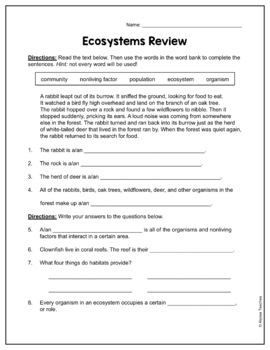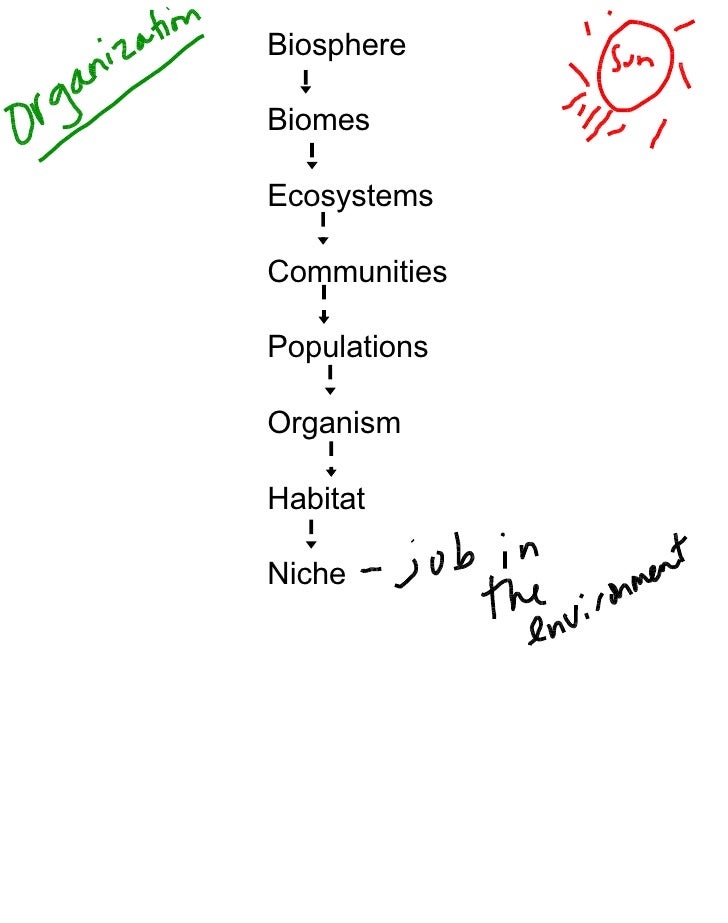Ecosystem Study Guide
Study 17 Ecosystems Study Guide flashcards from Emma W. On StudyBlue. This study guide review important vocabulary and key concepts that students need to learn in order to completely understand Ecosystems. It is a concise two. DDT- Kills insects, but makes eggshells thin, and easy to kill Biology Ecosystem Study Guide Sunlight- main source of energy source for life on earth -Some.
Living Systems – Ecosystems The student will investigate and understand how plants and animals in an ecosystem interact with one another and the nonliving environment, Key concepts include a) behavioral and structural adaptations, b) organization of communities, c) flow of energy through food webs, d) habitats and niches, e) life cycles: and f) influence of human activity on ecosystems. Ecology – the study of how living and nonliving things interact (p. Community – the living part of an ecosystem (p. Habitat – the home of an organism (p. A40) It provides everything a plant or animal needs to survive: food, water, shelter, safety.
Animals choose their habitats for the same reasons people choose where they live. Niche – The particular area within a habitat occupied by an organism (the role in a food chain) 5. Ecosystem – the living and nonliving things in an environment and all their interactions (p. A40) It can be small (a puddle of water) or large (the ocean). Adaptation – a special trait that helps an organism survive (to change in order to survive) 7. Structural adaptation –are physical features of an organism (the bill on a bird, the fur on a bear, a giraffe’s long neck, a fish has gills, camouflage, mimicry, the arctic hare’s ability to change color) 8.
Behavioral adaptation –the things organisms do to survive (bird calls, migration, spinning a web, moving in large groups, hibernation) 9. Organism – a living thing that carries out five basic life functions on its own (p.
Herbivore – a consumer that eats only plants (p. Carnivore – a consumer that eats only animals (p. 2014 dodge charger service repair manual. Predator –An organism that lives by preying on other organisms 13. Omnivore – a consumer that eats both plants and animals (p.
Consumer – any organism that eats the food producers make or eats other consumers (p. Decomposer – an organism that breaks down wastes and the remains of other organisms (p. A46) Decomposers help keep the environment CLEAN! They help to also break it down into the soil. Producer – an organism, such as a plant, that makes food (p. A46) They are the bottom of the food chain. They have the greatest amount of energy.
Food chain – the set of steps in which organisms get the food they need to survive (p. A48, B7) Made up of producers, consumers, and decomposers, keeps balance in the ecosystem 18. Food web – the pattern that shows how food chains are related (p. A50, B7) Shows how all organisms depend on one another for survival 19. Life cycle – the stages of growth and change of an organisms life (p. B58) (from young, to adult, to death) Additional Words to Think About: 20. Amphibian – a cold-blooded vertebrate that spends part of its life in water and part of its life on land (p.
Mammal – a warm-blooded vertebrate with hair and fur; female mammals produce milk to feed their young (p. Reptile – a cold-blooded vertebrate that live on land and has a backbone, an endoskeleton, and waterproof skin with scales or plates (p. Instinct – a pattern of behavior that requires no thinking because it is programmed into an animal’s brain (p.

Camouflage – an adaptation by which an animal can hide by blending in with its surroundings (p. Trait – a characteristic of a living thing (p. Mimicry – when one organism imitates the traits of another (p. Micro-organism – an organism that is so small you need a microscope to see it (p. Symmetry – the way an animal’s body parts match up around a point or central line (p. Warm-blooded – said of an animal with a constant body temperature (p. Cold-blooded – said of an animal that cannot control its body temperature (p.
Learned behavior – behavior that is not inborn (p. Inherited behavior – a behavior that is inborn, not learned (p. Vertebrate – an animal with a backbone (p.

Invertebrate – an animal without a backbone (p. Larva – a worm-like stage of some organisms that hatches from an egg during complete metamorphosis: a young organism with a form different from its parents (p. Pupa – a stage of some organisms that follows the larva stage; many changes take place as adult tissues and organs form (p. Nymph – a stage of some organisms that hatch from an egg during incomplete metamorphosis: a nymph is a young insect that looks like an adult (p. Population – one type of organism living in an area (p. Overpopulation – a depletion of resources that occurs when too many of at least one kind of living thing inhabitants an ecosystem (p.

Ecosystem Study Guide
Life span – how long something is expected to live (p. Evolution – the change in living things over time (p. Extinct – said of an organism no longer alive on Earth (p. Metamorphosis – the process an animal goes through to complete a life cycle (example: a caterpillar to a butterfly or a tadpole to a frog) 44. Hibernation – inactive or sleeping during winter 45.
Migration – moving to another area due to lack of food, temperature, or to have babies 46. Ways Animals/Plants Adapt: camouflage, body color, body coverings (shells, fur, scales, quills, armor), body shape, body movements, the ability to change colors, mimicry, dormancy, the way they taste or smell, the ability to loose a leg or arm, (defenses such as) stings, bites, pinching, migrating, hibernation, the ability to make themselves look bigger, the ability to store water.
The Five Basic Life Functions: 1) Living things grow and develop. 2) Living things use energy. They get energy by eating or making food. 3) Living things reproduce, or make more of their own kind. 4) Living things respond to the environment. 5) Living things get rid of waste. Complete Metamorphosis: (meal worms/butterflies) Incomplete Metamorphosis: (mayflies/grasshoppers) egg stage egg stage larva stage nymph pupa stage adult adult stage.
Ecosystem Study Guide Showing top 8 worksheets in the category - Ecosystem Study Guide. Some of the worksheets displayed are 113136, Skills work active reading, Exploring ecosystems, Lesson plan two, 5th grade lesson plan ecosystems, The food chain, Directions circle in the correct answer for the multiple, Interactions within ecosystems science test study guide. Once you find your worksheet, click on pop-out icon or print icon to worksheet to print or download. Worksheet will open in a new window. You can & download or print using the browser document reader options.